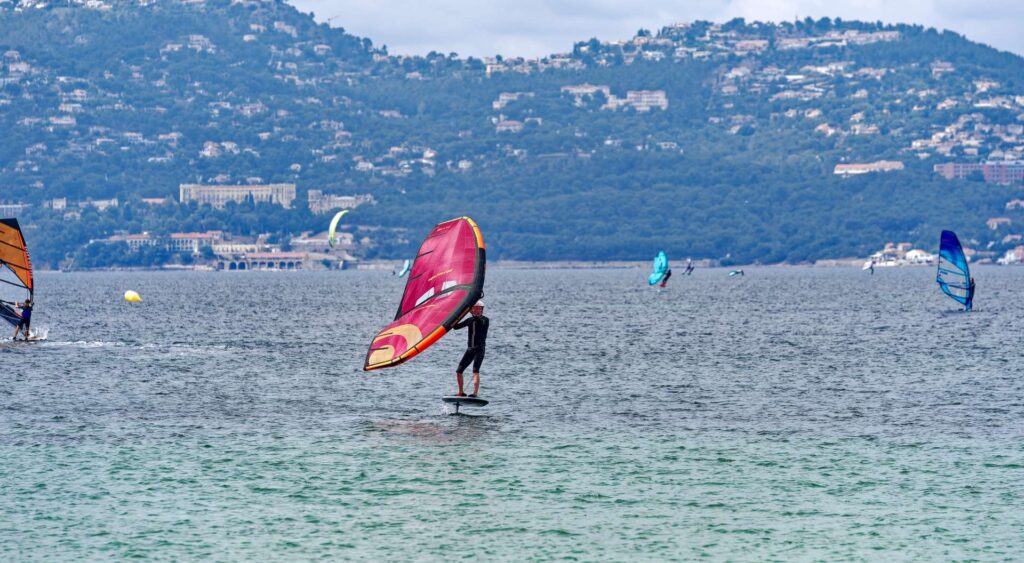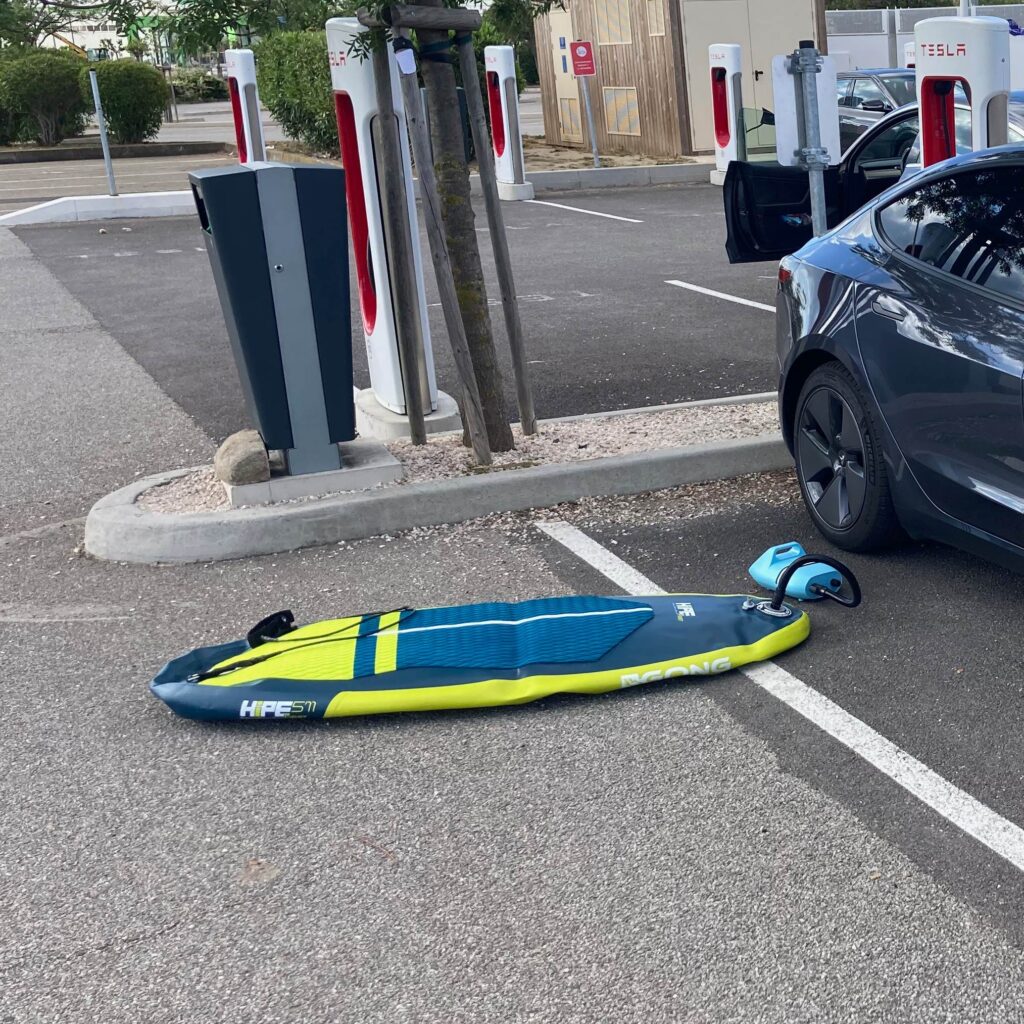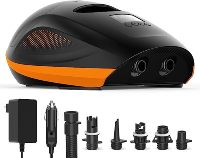Wingfoil is a great sport. It’s quick and easy to set up and get out into the water.
The only thing you have to do is mount your gear and inflate the wing.
You can choose between a rigid board or an inflatable board for more practicality. If you have an inflatable board, you can carry it easier while travelling, but you have to inflate it as well.
Inflating your wingfoil equipment is some work. But there are great solutions for this.
An electrical, portable pump can add so much comfort to your wingfoil session.
In general, you can choose between three options when it comes to inflating your wingfoil gear.
- Do it all manually, using the pump provided with your gear
- Do it all with an electric pump
- Let an electric pump do the biggest part of the work, finish off with the manual pump.

How to choose between a high pressure and low pressure electric wingfoil pump
There are high-pressure pumps and low-pressure pumps. High pressure pumps typically go up to 15 or 20 PSI, low pressure pumps are normally up to 0,5 or 1 PSI. That may sound like nothing, but it does take away about 50% to 80% of the manual work of inflating your gear! A small, low pressure pump is perfect to get the biggest chunk of your work done for you, if you don’t mind adding the last bit of air by hand. Or, in example, if you want to inflate your wing to hang it to dry in your garage.
There are some factors to take into consideration when choosing an electric wingfoil pump. Here’s the pro’s and cons in general for both options. Obviously, every model has it’s own specs, but this list gives you a good idea of what to expect.
High pressure pumps

- Typically used for SUP & Wing boards and wings
- Pressure up to 15 or 20 PSI
- Can do all the work
- Between 100-150 USD / EUR
- Digital display
- Charges on power outlet or car outlet
- Can come with USB charger for your phone
- Can come with flashlight
- Fits in your pocket
- Stops when reaching desired pressure
3 popular high pressure wingfoil electric pumps that make your life easier
Most pumps are compatible with most commonly used wing foil equipment material. However, it’s recommendable to keep a spare inflation tube from a pump or your own brand. Cut the part of that connects to the original manual pump and connect your electric pump to the original tube if the connector does not fit. That way you use the power of the electric pump but your original inflation tube. It ensures a perfect connection between the tube and your wing or board.
Pumping your equipment with an electrical pump various advantages: you safe a lot of energy for your wingfoil session, and it probably inflates faster than inflating manually, too. The three pumps below all have a max pressure of 20 PSI which is definately enough to inflate a SUP or WING board. They all have a strong battery too.
The benefit of these pumps is that you can use them without electricity, as they come with that handy, built-in battery. The battery has a high capacity. We tried the Topump TPS 300 and used it to inflate a 7,5 m2 wing, a 5,5 m2 wing and a 135 liters inflatable board. Both wings were inflated up to 5,5 PSI and the board up to 17 PSI. This consumed about 30% of the battery, which shows how powerful the battery and the pump is. You can easily inflate 5 wings and 2 boards before the battery runs out (probably more).
Topump TPS 300 Electric pump
(20 PSI)
- Battery: 7500 mAh
- Max pressure: 20 PSI
- Digital LCD display
- Support Bar and PSI on display
- Built- in battery
- USB port for phone charging
- No flashlight
- Can charge in the car
- Can charge at home
- Charge multiple wings and boards
SereneLife Electric pump
(20 PSI)
- Battery: 6000 mAh
- Max pressure: 20 PSI
- Digital LCD display
- Support Bar and PSI on display
- Built-in battery
- USB ports for phone charging
- Built-in flashlight
- Can charge in the car
- Can charge at home
- Charge multiple wings and boards
- Battery: 7800 mAh
- Max pressure: 20 PSI
- Digital LED display
- Support Bar and PSI on display
- Built-in battery
- No USB ports
- No flashlight
- Can charge in the car
- Can charge at home
- Charges multiple wings and board
Using smaller pumps (low pressure)
If you don’t want to spend over a hundred euros or dollars, you can choose to use a smaller pump. They will typically do the first 50% of the pumping work for you, they are a lot smaller to carry along with you, and they charge on a USB connection.
The advantages of a low-pressure electrical pump is that it probably fits in the pocket of your jacket. It’s a lot smaller and more practical to carry around (although the high pressure pumps are also small enough to cary).

A good example of a practical, small pressure pump that fits in your hand is the Giga Pump 2.0.
If will not fill up your wing or board completely and you will have to add air manually. However, it does help and for the price, it will take a big chunk of pumping off your workload.
It even has a built-in LED flashlight function, which can be handy in the dark. You cannot choose pumping pressure, the pump will just keep going. In order make sure it does not overheat, the producer recommends to stop it after 10 minutes.
Inflating your gear on the battery
When you are on the road, inflating can be very practical. You can inflate your winboard with an electric board pump with a battery while you’re having a break on the parking or charging your car, like in this picture. If you do it and you still have to drive a bit, you can fold down the back seat in the car and a 135 liters board will probably fit in your Tesla.
See more about travelling with wingfoil equipment.





